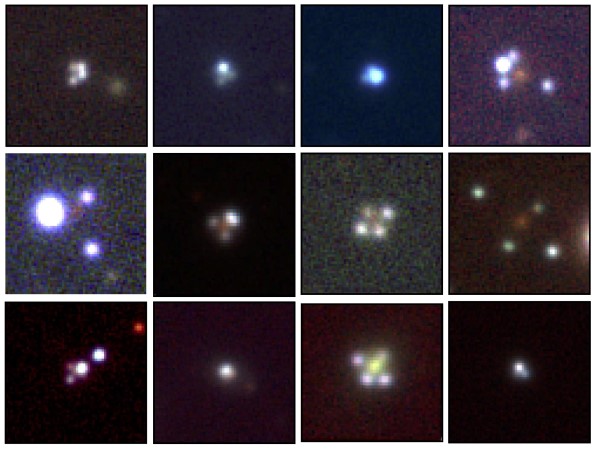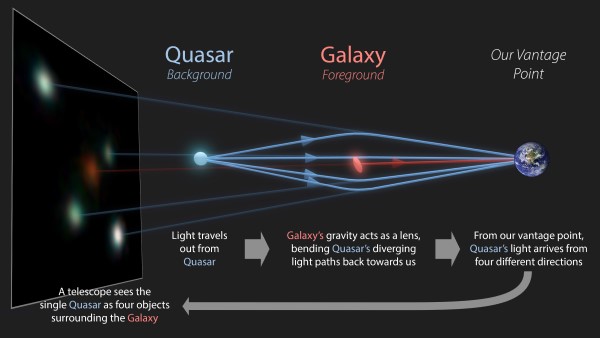12 rare Einstein crosses discovered with Gaia
7 April 2021
Thanks to ESA's star mapping spacecraft Gaia and machine learning, astronomers have discovered 12 quasars whose light is so strongly deflected by foreground galaxies that they are each visible as four distinct images, called an 'Einstein cross'. These crosses are unique tools to learn more about dark matter and the expansion rate of the Universe. |
| 12 Einstein crosses. Credit: The GraL Collaboration |
The idea that gravity could cause massive objects like galaxies to bend the fabric of spacetime, and thereby act like a lens and deflect the light coming from distant objects, was already predicted by Einstein as early as 1912. But the first double image of a lensed quasar was only discovered in 1979, and the first quadruple image in 1985.
Einstein crosses are rare, and since 1985 only around 50 had been discovered. "Finding new ones is difficult, because we have no clue where to search for them exactly. It requires high spatial resolution imaging just to locate candidates," says Francois Mignard of the University of Côte d'Azur in France and member of the Gaia Gravitational Lenses working group (GraL) [1] who published their latest findings in The Astrophysical Journal.
Gaia is a game changer in this field, because it is able to survey the whole sky every few months with unprecedented spatial resolution. The 12 newly discovered Einstein crosses increase the number of confirmed crosses by 25 percent.
The team used tailored machine learning methods to point out strongly lensed quasars as candidates in Gaia's Data Release 2. "Then we needed to confirm that the four closely packed images were not a pure chance alignment of four independent sources, but really four images of a single, distant source, lensed by an intervening galaxy," says team member Christine Ducourant of the University of Bordeaux in France.
As Gaia's spectrophotometric measurements are not yet published, photometry obtained by the NASA Wide-field Infrared Survey Explorer (WISE) was used to pre-select the most promising candidates for follow-up spectroscopy with ground-based telescopes [2], which confirmed that the 12 candidates were indeed quadruply-imaged quasars.
 |
| Lensing explained. Credit: R. Hurt (IPAC/Caltech)/The GraL Collaboration |
Multiply-imaged lensed quasars are unique tools to measure fundamental cosmological parameters like the Hubble-Lemaître constant, the Universe's present rate of expansion, the value of which is still disputed.
"Quasars are intrinsically variable objects, and because the light in each lensed image has crossed different paths in the Universe, fluctuations in the quasar's light show up in the images at different times. From this it is possible to estimate the Hubble-Lemaître constant," explains team member Alberto Krone-Martins of the University of California, Irvine, USA and from the Center for Astrophysics and Gravitation of the University of Lisbon, Portugal.
Another reason why astronomers search for multiply-imaged quasars, is that they can give valuable information about the distribution of dark matter in the foreground galaxies. "Based on general relativity and the distribution of matter in the galaxy, we can predict where the images of the lensed quasar should be. The difference between what we predict and what we observe, tells us something about the properties of different dark matter models," says Alberto. This requires further optical, radio and X-ray follow-up observations that are currently underway.
The Gaia Gravitational Lenses working group expects that many more multiply-imaged quasars can be found in the upcoming Gaia data releases, including the recently published Early Data Release 3.
"After the final data release, we hope that Gaia will discover hundreds of these sources. Thanks to Gaia and the collaboration between machine learning, space and ground-based observations, we are getting more and more effective at finding these unique objects," Christine adds.
[1] The Gaia Gravitational Lenses working group (GraL) is a collaboration with members from Australia, Belgium, Brazil, France, Germany, India, Portugal, Switzerland and the USA.
[2] Spectroscopic follow-up for the GraL program has used the Keck I telescope at Maunakea, Hawaii, the 200" Hale Telescope at Palomar Observatory, California, the 3.6-m New Technology Telescope (NTT) at La Silla, Chile, and the Gemini-South telescope at Cerro Pachon, Chile.
Notes for editors
"Gaia GraL: Gaia DR2 Gravitational Lens Systems. VI. Spectroscopic Confirmation and Modeling of Quadruply-Imaged Lensed Quasars" by Stern et al. is accepted for publication in The Astrophysical Journal. Preprint: https://arxiv.org/abs/2012.10051
For more information, please contact:
Timo Prusti
Gaia Project Scientist
European Space Agency
Email: tprusti![]() cosmos.esa.int
cosmos.esa.int


